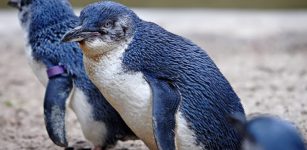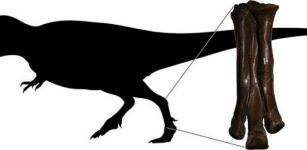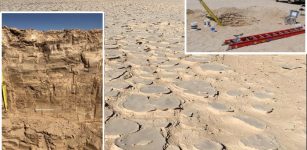Small Horned Dinosaur From China Walked On Two Feet
Eddie Gonzales Jr. – MessageToEagle.com – Many dinosaur species are only known from scant remains and it is known that about 75 percent of known dinosaur species are known from only five or fewer individuals.
Auroraceratops rugosus, was known, though insufficiently, from 2005 discovery in form of a single skull from the Gobi Desert in northwestern China.
 An artist’s rendering of Auroraceratops shows its bipedal posture as well as the beak and frill that characterize it as a member of the horned dinosaurs. Paleontologists from Penn led a team in characterizing this species, discovered in China. (Illustration: Robert Walters)
An artist’s rendering of Auroraceratops shows its bipedal posture as well as the beak and frill that characterize it as a member of the horned dinosaurs. Paleontologists from Penn led a team in characterizing this species, discovered in China. (Illustration: Robert Walters)
Today, Auroraceratops rugosus is well-documented species thanks to more than 80 individual Auroraceratops, bringing this small-bodied plant-eater into the ranks of the most completely known dinosaurs.
In a new paper, researchers from several institutions, describe the anatomy, age, preservation, and evolution of this large collection of Auroraceratops.
Their analysis places Auroraceratops, which lived roughly 115 million years ago, as an early member of the group Ceratopsia, or horned dinosaurs, the same group to which Triceratops belongs.
In contrast to Triceratops, Auroraceratops is small, approximately 49 inches (1.25 meters) in length and 17 inches (44 cm) tall, weighing on average 34 pounds (15.5 kilograms).
While Auroraceratops has a short frill and beak that characterize it as a horned dinosaur, it lacks the “true” horns and extensive cranial ornamentation of Triceratops.
A robust set of fossils of Auroraceratopsto characterizes the dinosaur, including near-complete skeletons. More than 80 individuals of the species have been identified since it was initially named 15 years ago. (Illustration: Scott Hartman)
“When I first saw this animal back in 2004, I knew instantly it was a new kind that had never been seen before and was very excited about it,” paleontologist Peter Dodson, senior author on the work, said in a press release.
“This monograph on Auroraceratops is long-awaited.”
Auroraceratops represents the only horned dinosaur in the group Neoceratopsia (the lineage leading to and including the large bodied ceratopsians such as Triceratops) from the Early Cretaceous with a complete skeleton.
Horned dinosaurs transitioned from being bipedal, like their ancestors, to being the large rhinoceros-like quadrupedal animals most people think of as horned dinosaurs during the later parts of the Cretaceous.
“Before this study, we had to rely on Psittacosaurus, a more distantly related and unusual ceratopsian, for our picture of what the last bipedal ceratopsian looked like,” said Eric Morschhauser, a lead author of the paper.
Auroraceratops preserves multiple features of the skeleton, like a curved femur and long, thin claws, that are unambiguously associated with walking bipedally in some dinosaurs.
“It can now provide us with a better picture of the starting point for the changes between bipedal and quadrupedal ceratopsians,” adds Morschhauser.
Written by Eddie Gonzales Jr. – MessageToEagle.com Staff











